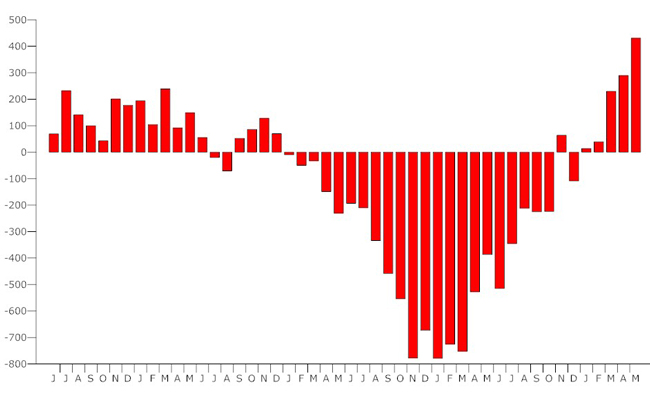
Total nonfarm payroll employment grew by 431,000 in May, reflecting the hiring of 411,000 temporary employees to work on Census 2010, the U.S. Bureau of Labor Statistics reported today. Private-sector employment changed little (+41,000). Manufacturing, temporary help services, and mining added jobs, while construction employment declined. The unemployment rate edged down to 9.7 percent, the rate where it stood for the first three months of the year.
The numbers mask some bad news: private-sector employment is growing, but barely, and it is nowhere near its growth rate of a month earlier. If it weren’t for census workers, job creation would have been near zero. The economy may be headed for a second dip into recession.
Click On:
- Flagler Unemployment Lowest in a Year
- April: Job Creation Soars by 290,000, Unemployment at 9.9%
- March: At 16.6%, Flagler Unemployment Crawls Lower
- March: US Economy Adds 162,000 Jobs, 1st Increase Since 2007
- January: 16.9% Unemployment in Flagler, 11.6% in Fla.
- Franklin D. Roosevelt’s Second Bill of Rights: For Workers
- Where and how to file for unemployment
- Complete April 2010 Florida Unemployment Report
In the sector most relevant to Florida and Flagler County, construction jobs in May fell by 35,000, essentially wiping out gains recorded in that sector in March and April.
The Federal government hired 411,000 temporary workers for Census 2010, bringing total temporary census staffing during the payroll survey reference period to 564,000. Employment in state government excluding education decreased
by 13,000.
Average hourly earnings of all employees in the private nonfarm sector increased by 7 cents, or 0.3 percent, to $22.57 in May. Over the past 12 months, average hourly earnings have increased by 1.9 percent. In May, average hourly earnings of private-sector production and nonsupervisory employees increased by 4 cents, or 0.2 percent, to $18.99.
The average workweek for all employees on private nonfarm payrolls increased by 0.1 hour, to 34.2 hours, the Labor Department reports. The manufacturing workweek for all employees increased by 0.3 hour to 40.5 hours. The average workweek for production and nonsupervisory employees on private non farm payrolls increased by 0.1 hour to 33.5 hours over the month.
Polled by Thomson Reuters, economists ahead of the jobs report forecast a gain of 513,000 jobs, but also attributed the bulk of the gains to federal government hiring of census workers. The forecast saw a dip in unemployment to 9.8 percent in May from 9.9 percent a month earlier.
Even temporary hiring is good for the economy. It means more consumers with more money in their pocket in an economy that depends overwhelmingly on consumer spending (70 percent of the American economy is driven by consumption). But the blip may be just that in light of increasing nervousness across world markets. “It’s not quite a Lehman moment,” The Economist warns this week, “but financial markets are more anxious today than at any time since the global recovery took hold almost a year ago.” Europe’s debt crisis is dragging down the young recovery in the American economy, itself teetering now that stimulus money is petering out, including, for Florida, the end, in April, of the $8,000 tax credit first-time home-buyers could splurge on.
In April, Florida’s unemployment rate declined for the first time since February 2006, falling to 12 percent from 12.3 percent the previous month. A surge in government and tourism jobs was responsible for the majority of new jobs. Federal jobs, led by census employment, accounted for 8,100 of the of the new jobs. State government lost 300 jobs, and local governments added just 100 jobs. But the oil slick approaching Florida is putting more tourism jobs in doubt.





























Electronic Circuits · says
construction jobs are on the rise again these days because the recession is almost over ,*.